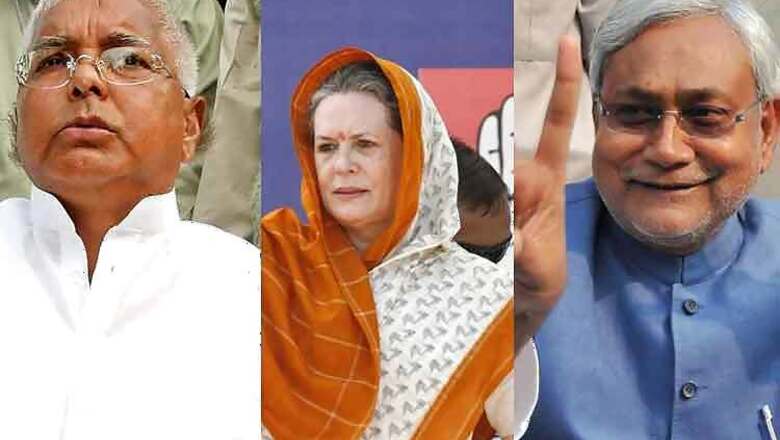
views
Much awaited Bihar assembly elections are over and the results are here. These elections come after 500 days of Narendra Modi's government at the Centre, six months after its humiliating defeat in the Delhi assembly elections, at a crucial stage in testing BJP's centralised power concept (Modi + Amit Shah) and on the back drop of rising intolerance. All these factors combined with Prime Minister's 30 rallies in the state had brought nation's attention to Bihar elections and the outcome is expected to influence anti-NDA efforts at the national level. Anti-corruption crusader and current Delhi Chief Minister Arvind Kejriwal also extended his support to once his "Fast unto Death against Corruption" victim UPA co-led Mahagatbandhan.
Just like Lok Sabha elections and Delhi assembly elections, Bihar elections also disproved most of the exit polls. Mahagatbandhan (JDU+RJD+INC) won 178 out of 243 assembly seats and its 3 out of every 4 seats victory suggests a clean sweep and an overwhelming voters support in the state. BJP and its allies LJP, RLSP and HAM won 58 seats out of remaining 65 to make the much hyped contest one-sided and provide an interpretation of thumbs down for Modi in referendum. However, a closer look at the results provide a different story altogether and exposes the dark side of First-Past-The-Post (FPTP) voting.
FPTP or Winner-Takes-All election is one that is won by candidate receiving more votes than any other – implying a candidate receiving 1 extra vote can be declared as a winner and 243 such extra votes can make a party win all 100% seats in a hypothetical scenario. This method discounts the opinion of sizable voters in forming a state government.
Here is an attempt to compare Bihar's two recent elections 2014 Lok Sabha and 2015 Assembly to understand the impact of FPTP on winning seats/majority. Though the objectives of both elections are different; but, the electoral process, electoral region and electorate are largely the same. A head on comparison of these two elections is an apple vs orange comparison in many aspects, but not necessarily for decoding FPTP.
RJD and Congress had fought 2014 Loksabha elections together and BJP, LJP and RLSP contested under NDA banner, while JDU contested independently. Table 1 provides the data of individual votes secured, % of total valid votes, % of seats won by each party in 2014 and 2015 elections.

2014 Lok Sabha elections:
Bihar has 40 parliament constituencies and 3,53,04,368 voters participated in 2014 elections from the state. The elections were held in usual FPTP method and candidate getting as low as one extra vote was declared as a winner. 1,39,17,427 votes (39.41% of valid voted) were polled for NDA, and had won them 77.5% (31/40) of Lok Sabha seats. JDU and RJD+Congress contested independently and received 16.04% and 29.02% of votes to win 5% and 15% seats respectively. However, JDU and RJD+Congress cumulatively (Mahagatbandhan - did not exist in 2014) received 1,59,08,402 votes (45.06% of votes) but a mere 20% seats. First-Past-The-Post Voting system helped NDA in bagging majority of the seats.
2015 Bihar Assembly elections:
The same 40 constituencies are further divided into 243 assembly segments and approximately 3,81,47,602 (28 lakhs more than 2014 Lok Sabha elections) residents voted for the state assembly. Unlike 2014, JDU and RJD+Congress contested under Mahagatbandhan umbrella and secured 16.8%, 25.1% votes and 29.22%, 44.03% seats respectively. Altogether, Mahagatbandhan received same number of votes (1.59 crore votes) as 2014 or 3% less percentage of valid votes (down to 41.9% from 45.06%) but was still able to bag 73% of seats in 2015 compared to 20% seats in 2014. HAM is the new split party from JDU and contested under NDA umbrella along with BJP, LJP, RLSP in 2015 elections. 34.1% of voters favored NDA compared to 39.4% in 2014 but this support translated into mere 23.9% seats.
Summarily, 42% JDU, RJD+Congress valid votes under Mahagatbandhan umbrella fetched them 73% of assembly seats, but 45% of the state support (votes) in 2014 as individual players resulted in mere 20% Parliament seats. In NDA case, 39% of the state support (voters) converted into 78% Lok Sabha seats whereas 34% votes in 2015 got translated to mere 24% assembly seats. The major difference between these two elections is that JDU, RJD and Congress clubbed their votes before polling/counting in 2015; and that did not happen in 2014.
First-Past-The-Post election system favored NDA in 2014's three major player contest (NDA, JDU, UPA) and the same system hurt them in 2015's two major player contest (NDA, Mahagatbandhan). Delhi elections were another classic example where the same percentage of valid votes resulted in 31 seats (2013 assembly) and 3 seats (2015 assembly) for NDA. Opinion of the voter always played a major role in a democratic system; however FPTP election seems to have a significant impact on the outcome too. The nation mood to bring a decisive leader in 2014 elections favored NDA whereas nonexistence of such local leader in Bihar hurt them in 2015. The current voting system and our compromise to vote for a lesser evil seem to impact the beauty of democracy.
The rhetorical statements such as defeat of communal politics or thumbs down to Modi's performance on the eve of Bihar results sound more half-baked truth and undermine the deficiencies in our electoral system. NDA still retained 93.3% of their 2014 Lok Sabha votes in 2015 Bihar assembly elections. An old supporter might have gone and a new supporter might have joined but the overall support looks largely intact for NDA. The space free of communal, caste and corrupt politics is still largely vacant as most of the current attempts are targeted to selectively fill either anti-BJP or anti-Congress gaps.
Author Akshay Kumar Anugu is a USA Food Scientist by profession and coordinated several Aam Aadmi Party 2013-2015 electoral campaigns from US. He no longer work with AAP and has no political affiliations.




















Comments
0 comment